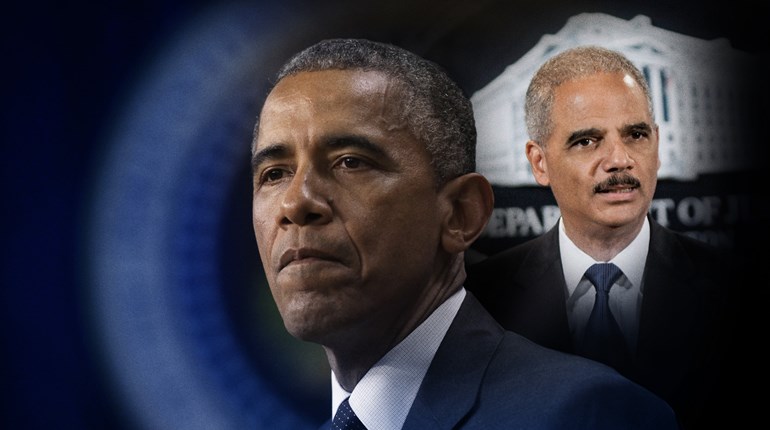
The Obama administration’s gunrunning scandal, known as “Operation Fast and Furious,” is still being dragged, document by document, into the light.
If you recall, this is the operation run by the Bureau of Alcohol, Tobacco, Firearms and Explosives (ATF) in which the ATF told gun store owners to sell gun runners as many firearms as they wanted. The ATF didn’t put tracking devices in the guns. They didn’t follow them with drones. The ATF even told agents who tried to follow the guns to “stand down.” The ATF simply let as many as 2,000 guns go into the arsenals of criminals (mostly Mexican drug cartels). Two of these ATF-supplied guns were found at the crime scene where U.S. Border Patrol Agent Brian Terry was murdered by drug runners in December 2010.
A congressional investigation has been ongoing since early 2011.
In January, U.S. District Court Judge Amy Berman Jackson ordered the U.S. Justice Department to produce the documents related to Operation Fast and Furious by Feb. 2. On April 8, just before a deadline for appeal was to expire, the Obama administration released 20,500 pages of internal emails and other documents.“More than previously understood, the documents show the lengths to which senior department officials went to keep information from Congress.” — Rep. Jason Chaffetz, chairman of the House Committee on Oversight and Government Reform
The Obama administration is hoping this is now over—but it’s not.
After releasing this batch of documents, Justice Department Legislative Liaison Peter Kadzik said as much in a letter to the chairman of the Committee on Oversight and Government Reform, Rep. Jason Chaffetz, R-Utah. “In light of the passage of time and other considerations, such as the Department’s interest in moving past this litigation and building upon our cooperative working relationship with the Committee and other Congressional committees, the Department has decided that it is not in the executive branch’s interest to continue litigating this issue at this time,” Kadzik wrote.
Chaffetz, however, isn’t satisfied.
President Barack Obama has used an “executive privilege” claim to keep these documents from Congress—he is still doing this with many more documents. The cover-up was so obvious that, in 2012, Congress held then Attorney General Eric Holder in contempt.
Chaffetz just published an initial report on the released documents.
“More than previously understood, the documents show the lengths to which senior Department officials went to keep information from Congress,” Chaffetz said. “Further, the documents reveal how senior Justice Department officials—including Attorney General Eric Holder—intensely followed and managed an effort to carefully limit and obstruct the information produced to Congress.”
During its investigation, “the Justice Department has provided false information, stonewalled document requests, produced scores of blacked-out pages and duplicate documents in order to bolster its page count for public relations purposes, and refused to comply with two congressional subpoenas,” said Chaffetz.
After the Obama administration opted to finally release some documents, Chaffetz said, “Today, under court order, DOJ turned over some of the subpoenaed documents. The Committee, however, is entitled to the full range of documents for which it brought this lawsuit. Accordingly, we have appealed the District Court’s ruling in order to secure those additional documents.”
Even these handpicked documents that were released to pacify the congressional committee include revelations about how the administration’s cover-up took place.
According to Chaffetz’s report, here are a few examples of what Obama administration officials were discussing:
- Deputy Assistant Attorney General Jason Weinstein suggested that he email the ATF leadership “offering any assistance they need for the [Sen. Charles] Grassley briefing.”Weinstein also advised that “ATF can and should strongly refute’” that a Fast and Furious weapon was involved in the Brian Terry attack.”
- On June 17, 2011, in response to news reports that firearms used in a high-profile kidnapping and murder were linked to Fast and Furious, Associate Deputy Attorney General Matt Axelrod emailed ATF, asking: “Were two F&F guns actually traced to the scene of this kidnapping? Can you run that down for us?”ATF dismissed the connection by responding that day: “[T]o suggest the guns are linked is like saying there was a murder in southeast three weeks ago. Tonight a car load of guys g[o]t caught with guns in southeast. Ergo the guns are linked to the murder.”
- After Rep. Darrell Issa, R-Calif., and Sen. Chuck Grassley, R-Iowa, wrote to the Ambassador of Mexico on June 21, 2011, to ask for further details, DOJ asked more questions of ATF.Subsequently, on June 22, 2011, Associate Deputy Attorney General Matt Axelrod emailed senior officials: “I just heard from ATF. Their initial reporting on this was incorrect. Evidently, when MX law enforcement arrested the kidnappers at their hideout, they seized a number of firearms, two of which tie back to Fast and Furious. I’ll double check Issa’s letter in the morning, but it appears that the allegations in it (and in the Fox News report) are accurate.”
- On March 9, 2011, Assistant Attorney General for Legislative Affairs Ron Weich forwarded a letter from the National Rifle Association to a group of senior Justice Department officials. The letter urged the House Judiciary Committee to hold hearings on ATF firearm trafficking enforcement tactics. Weich stated: “Chutzpah. The NRA’s now-public involvement in this may be useful in convincing reporters that this is part of the overall effort to discredit ATF.”
- When determining how the Department would describe information being withheld, on Sept. 19, 2011, DOJ lawyer Paul Colborn suggested “deleting the sentence giving a page count on our memos on memos withholding.”
- On Oct. 5, 2011, DOJ Office of Public Affairs Director Matthew Miller emailed Attorney General Eric Holder: “If I were you, I would want answers from the entire team ([Deputy Attorney General Jim] Cole, [Associate Deputy Attorney General Steven] Reich, on down), on why the Department let Issa decide what to do with these memos. The whole point of the review is to find things like this and come up with plans for dealing with them. It should have been obvious that these memos were going to be a huge target, and instead of just handing them over, the Department should have put them out to reporters on its own terms, instead of letting Issa do it. Give them to Issa at the same time you give them to the press with an explanation that takes the air out of the balloon. And if the answer is we owe it to Issa to give him this stuff first—well, that’s obviously ridiculous.” (Holder forwarded the email to his chief of staff, Gary Grindler, with the comment, “I agree.”)
- On March 16, 2011, an ATF official weighed in on the DOJ’s response to a letter from House Judiciary Committee Chairman Lamar Smith. Chairman Smith’s letter asked several questions about Operation Fast and Furious, including, “How many weapons have been allowed to pass to Mexico under the program known as ‘Fast and Furious’”? The ATF official advised senior Justice Department officials to exclude key information from their response. He wrote: “We would suggest that you pull the sentence that notes how many weapons we’ve recovered. It squares poorly with how many we haven’t.”
That’s just some of what was released in the 20,500-page document dump, but it should be enough to make any reporter hungry to know what’s in the unreleased documents. Nevertheless, many in the so-called mainstream media aren’t interested in reporting any of this. When they do touch on it, they misunderstand and downplay the scandal.“Chutzpah. The NRA’s now-public involvement in this may be useful in convincing reporters that this is part of the overall effort to discredit ATF.” — Ron Weich, assistant attorney general for legislative affairs
Here’s how The Atlantic treated this document release: “Remember Fast and Furious? No, not the series of vehicle-themed Vin Diesel and Rock vehicles. The bizarre ‘gunwalking’ scandal, in which the ATF let straw buyers purchase guns to traffic to Mexico, but intercept the firearms before they reached Mexico, snagging criminals.”
This insinuates the ATF tried to follow and grab the guns and criminals before the guns made it to Mexico. There is no evidence that the ATF ever did that until after the scandal broke and after thousands of guns had been run across the border.
In its last paragraph The Atlantic concluded: “The scandal has lost its political intrigue—Obama is in the home stretch of his presidency, and Holder left the administration last year. But perhaps the documents will finally allow a clear picture of whether there was a vast conspiracy to cover up Fast and Furious or whether, as the White House insists, this was only ever the story of a few rogue agents.”
Perhaps if this reporter, and so many others in the mainstream media, had simply investigated a little—even just looked into the emails quoted in this article—they’d have their answers. Then they might educate the public about a mad government operation and obvious cover-up after an American was murdered.


































